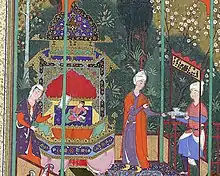Ifra Hormizd
Ifra Hormizd (Modern Persian: ایفرا هرمز) or Faraya Ohrmazd (Modern Persian: فرایه هرمز) was a Sassanid noblewoman, spouse of Hormizd II and mother of Shapur II.[2] She was the regent during the minority of her son between 309 and 325.
| Ifra Hormizd | |
|---|---|
| Reign | 309 AC |
| Coronation | 309 AC |
| Predecessor | Adur Narseh |
| Successor | Shapur II |
| Spouse | Hormizd II |
| Issue | Shapur II |
| House | House of Sasan |
| Religion | Christianity[1] |

Following the death of Hormizd, and the crisis of succession that followed, the noblemen of the country decided to hand over power to the last child of Hormizd, who had not yet been born of Ifra. Thus, the crown was placed on Ifra's belly, and she ruled over the country with nobles from 309 until the adulthood of her son, Shapur, who was declared mature to rule himself at age sixteen in 325.
Etymylogy
There isn't much information about Ifra Hormizd's name, and only Jewish sources mentioned her name.[1] Theodor Nöldeke also finds the name "Ifra" unclear.[1]
Life
Ifra Hormizd had a Jewish father and she converted to Christianity later. There have been many accounts throughout history of her friendly relations and cooperation with the Jews at the court in achieving their goals. She has been mentioned in five chapters of Talmud. Talmud represents Ifra as a queen with interest in Judaism.
According to a Nestorian chronicle, the father of Shapur II's mother was Jewish.[1] According to the corresponding chronicle, Ifra Hormizd was converted to Christianity by Shemon Bar Sabbae and it was one of the main reasons for execution of Shemon and persecution of Christians during reign of Shapur II.[1]
Regency
Following the death of Hormizd II (r. 302–309), his son Adur Narseh (r. 309–309) succeeded him, but after a while he was deposed and killed by noblemen.[3] Nobles then blinded Hormizd's second son[4] and his third son who was named Hormizd, was imprisoned. He escaped the prison shortly afterwards and took refuge in Roman Empire.[5] Therefore the throne of Sassanid empire was considered for the unborn son of Hormizd by his wife Ifra Hormizd, who later became Shapur II (r. 309–379).[6]
References
- Neusner 1969, p. 35.
- Daryaee 2009.
- Tafazzoli 1983, p. 477.
- Al-Tabari 1991, p. 50.
- Shahbazi 2004, pp. 461–462.
- Daryaee 2014, p. 16.
Sources
- Daryaee, Touraj (2009). "Šāpur II". Encyclopaedia Iranica.
- Neusner, Jacob (1969). A History of the Jews in Babylonia, Part 4. The Age of Shapur II. Brill. ISBN 9789004021471.
- Tafazzoli, Ahmad (1983). "Ādur Narseh". Encyclopaedia Iranica, Vol. I, Fasc. 5. p. 477.
- Al-Tabari, Abu Ja'far Muhammad ibn Jarir (1991). Yar-Shater, Ehsan (ed.). The History of al-Ṭabarī, Volume V: The Sasanids, the Byzantines, the Lakhmids, and Yemen. Trans. Clifford Edmund Bosworth. Albany, NY: State University of New York Press. ISBN 0-7914-0493-5.
- Shahbazi, A. Shapur (2004). "Hormizd (2)". Encyclopaedia Iranica, Vol. XII, Fasc. 5. pp. 461–462.
- Daryaee, Touraj (2014). Sasanian Persia: The Rise and Fall of an Empire. I.B.Tauris. pp. 1–240. ISBN 978-0-85771-666-8.